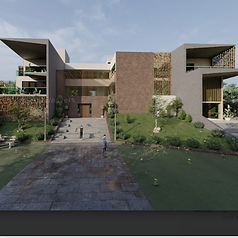Contact : +91 9632587562
The Essence of Modern Architecture: Redefining Spaces with Innovation
Modern architecture is a design philosophy that emerged in the early 20th century, characterized by its departure from traditional styles and its embrace of new materials and technologies. This architectural movement prioritizes simplicity, functionality, and the integration of natural light, reshaping the way we experience and interact with spaces.
Key Characteristics of Modern Architecture
1. Minimalist Aesthetics: One of the hallmarks of modern architecture is its minimalist approach. Clean lines, geometric forms, and a lack of ornate detailing are fundamental. This simplicity is not merely aesthetic but functional, focusing on the essential aspects of design and eliminating unnecessary embellishments.
2. Use of New Materials: Modern architecture often incorporates innovative materials such as steel, glass, and reinforced concrete. These materials enable architects to create structures that are not only aesthetically pleasing but also functionally robust. The extensive use of glass, for instance, enhances natural light flow and creates a seamless connection between indoor and outdoor spaces.
3. Open Floor Plans: Modern architecture favors open, flexible floor plans that promote a sense of openness and fluidity within a space. Walls are minimized to create large, unobstructed spaces that encourage interaction and adaptability. This design approach supports a lifestyle that values spaciousness and connectivity.
4. Integration with Nature: A significant aspect of modern architecture is its integration with the natural environment. Large windows and open spaces are designed to bring the outdoors inside, enhancing the connection between occupants and their surroundings. Sustainable practices are also emphasized, with green roofs, solar panels, and energy-efficient systems becoming increasingly common.
5. Functionality and Purpose: Modern architecture places a strong emphasis on functionality. The design of each space is intended to serve a specific purpose, with practical considerations guiding aesthetic choices. This focus on usability ensures that spaces are not only beautiful but also highly functional.
Evolution and Influence
Modern architecture has evolved over time, influenced by various movements and technological advancements. The Bauhaus movement, for example, played a crucial role in shaping modern architectural principles, advocating for the unity of art and technology. Architects like Le Corbusier and Frank Lloyd Wright further contributed to this evolution, introducing innovative concepts and designs that continue to inspire contemporary architecture.
Modern Architecture in Practice
Today, modern architecture is prevalent in both residential and commercial buildings. High-rise buildings, contemporary homes, and innovative public spaces all showcase the principles of modern design. Architects and designers continue to explore new materials, technologies, and methods to push the boundaries of what modern architecture can achieve.
In residential settings, modern architecture often translates to sleek, energy-efficient homes with open interiors and a strong connection to nature. Commercial spaces, on the other hand, may feature striking facades, sustainable design elements, and cutting-edge technologies that reflect a company’s brand and values.
The Future of Modern Architecture
As we move forward, modern architecture will likely continue to evolve, driven by advances in technology and a growing awareness of environmental sustainability. The integration of smart home technologies, sustainable building practices, and innovative design solutions will shape the future of modern architecture, ensuring that it remains relevant and impactful.
In conclusion, modern architecture represents a dynamic and forward-thinking approach to design. Its emphasis on simplicity, functionality, and integration with the natural environment not only enhances the aesthetic appeal of spaces but also improves their practicality and sustainability. As architectural trends continue to evolve, modern architecture will undoubtedly remain at the forefront of innovation and design.
